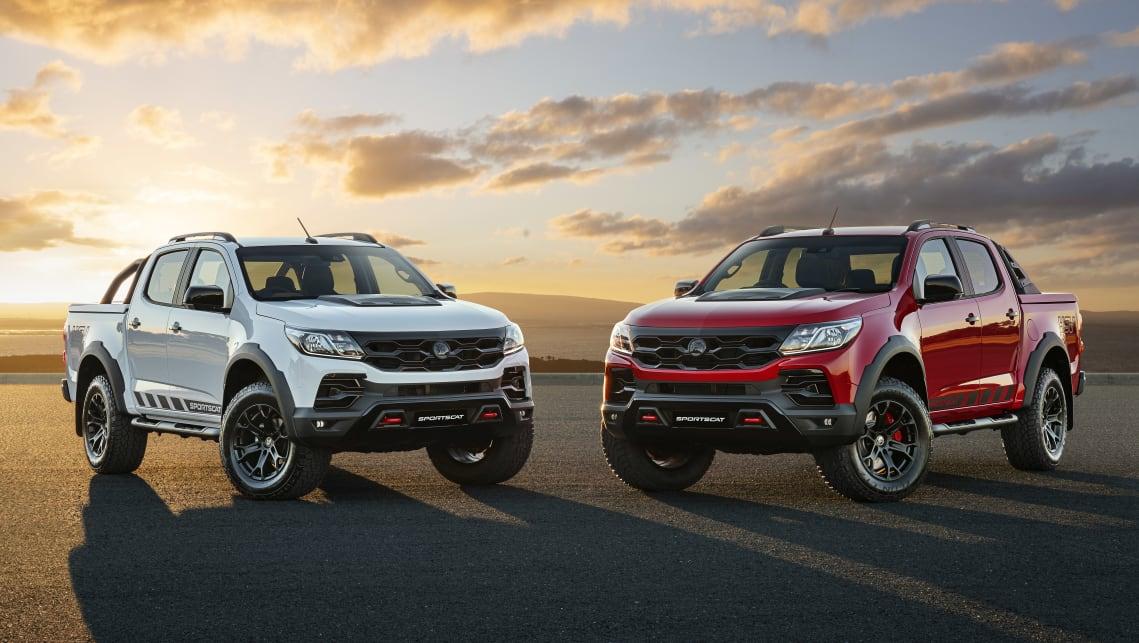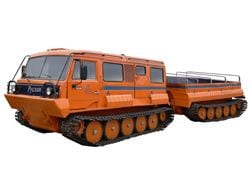
2020 HSV SportsCat Review: Series II
Content
- Is there anything interesting about its design? 8/10
- How practical is the interior space? 8/10
- Does it represent good value for money? What functions does it have? 8/10
- What are the main characteristics of the engine and transmission? 7/10
- How much fuel does it consume? 7/10
- What is it like to drive? 8/10
- What safety equipment is installed? What is the safety rating? 7/10
- How much does it cost to own? What kind of guarantee is provided? 7/10
- Verdict
- Would you prefer a SportsCat Ranger Raptor? Let us know about it in the comments.
The SportsCat Series II may not be the type of HSV we've become accustomed to over the years. But it normal. Because HSV is no longer the brand we are used to. You see, their core product has changed. And so their main customer has changed along with it.
In fact, HSV thinks it's almost starting again; is rebuilding its customer base (and even its newsletter subscriber base) as it transitions from powerful Commodores to imported Camaros, and this is the SportsCat Series II based in Holden, Colorado.
It looks solid, it has better equipment and finishes than the Holden, but its diesel - yes, diesel - does not provide one kilowatt of extra power.
“We see it as performance, just different performance,” HSV tells us, pointing to the off-road qualities of the ute rather than some brilliant power figures.
So does this Colorado SportsCat live up to the HSV story? And, more importantly, does it paint a rosy picture of the future of HSV?
| HSV Colorado 2020: Sportscat SV (4X4) | |
|---|---|
| Safety Rating | - |
| engine's type | 2.8 L turbo |
| fuel type | Diesel |
| Fuel efficiency | 7.9l / 100km |
| Landing | 5 Places |
| Price from | $50,500 |
Is there anything interesting about its design? 8/10
HSV has sold close to 1200 SportsCats to date, so they had a lot of people to talk to when planning this Series II update. The brand held feedback sessions with current owners, potential buyers and those who had already bought a competing model asking if they would like the HSV to behave differently this time around.
The Sportscat's front end is raised by 45mm, giving the HSV a flatter, sportier ride on the road.
Answer? More HSV.
That's why this Series II car is plastered with HSV logos everywhere you look, from dashboard trim, floor mats and seatbacks to giant decals on the side and rear of the car. Then there is little chance of confusing it with a regular Colorado.
The Series II ute has HSV logos everywhere you look.
Elsewhere, however, the front end design is unique to the HSV and the brand has focused on adding black wherever possible to give the SportsCat a stiff feel. That's why the license plate surround and front skid plate have changed from silver to black, and the wheels have also been blacked out.
The Sailplane's matte black design was inspired by wakeboarding boats, while a body-coloured rigid body (which lifts up like a hatchback's trunk) gives the rear a finished, one-piece look.
Inside, the SportsCat Series II harkens back to the old HSVs, with big, comfortable seats with so much lateral support you'll almost need a ladder to climb over them, signature suede dashboard inserts, and an improved sports steering wheel. Parked side by side, the difference between this and the Colorado it's based on is noticeable.
The Series II cabin features high-support sports seats.
Perhaps the most noticeable difference between it and the Holden is the ride height. While the Coloardo has nose-down styling, the SportsCat has been raised 45mm up front, giving the HSV a flatter, sportier ride on the road.
How practical is the interior space? 8/10
The pitch from HSV here is that SportsCat is the best deal in the world; one that is sportier on the road but no less capable off the road.
The main specifications correspond to those of a double cab vehicle, with a towing braking capacity of 3500 kg and a payload (with passengers) of 876 kg (automobile) and 869 kg (manual).
All SportsCat models feature low-range all-wheel drive, limited-slip differential and crankcase protection, while SV models also feature a smart anti-roll bar that stiffens the chassis on the road for better handling. , but then automatically turns off when low range is engaged, so off-road capability is not affected.
The tray on the HSV has a hard lid that opens like a normal trunk.
HSV says the ride height is 251mm and the approach, exit and ramp angles are 32, 24 and 27 degrees.
Having just spent time wrestling with the sliding lid that slides out over the Ford Ranger's pan, I like the HSV solution with a hard lid attached to the cab so it opens up like a normal trunk. The slowly lowering tailgate also saves your knees.
Does it represent good value for money? What functions does it have? 8/10
The SportsCat lineup has been downsized and renamed for this Series II edition, while the Look Pack and SportsCat+ have been rebadged SportsCat V and SV.
The SportsCat V carries the sticker for $62,490 while the SV raises the asking price to $66,790. Swapping out the standard manual for a six-speed automatic adds to the price of $2200, but you can also remove some of the V-trim features (rigid body and sports steering wheel) to bring down the asking price with the manual to $59,990.
To put that into perspective, the Colorado Z71 that this SportsCat is based on costs $57,190.
So what do you get for the extra cost? Strength.
Outside, you'll find 18-inch forged alloy wheels (black, of course) wrapped in Cooper all-terrain tires, as well as a redesigned front fascia and grille, LED fog lights, rigid bodywork, and a sports steering wheel. Inside, expect high-support HSV sports seats, a new leather-wrapped steering wheel and a new suede dash trim. The 8.0-inch touchscreen is equipped with Apple CarPlay and Android Auto, and you get a seven-speaker stereo system and dual-zone climate control.
18-inch forged wheels wrapped in Cooper all-terrain tires.
All SportsCats models are equipped with on-the-fly XNUMXWD, limited slip differential and oil pan protection, while SV models are also equipped with a smart anti-roll bar that disengages the clutch. The SV trim also gets upgraded brakes, with the HSV fitted with AP Racing calipers up front, and larger rotors and brake master cylinders.
What are the main characteristics of the engine and transmission? 7/10
The SportsCat still has the same horsepower as its Colorado sibling, with a 2.8-liter Duramax turbodiesel engine producing 147kW and 500Nm (or 440Nm with a manual transmission).
It comes with a six-speed manual transmission as standard, but can be paired with a six-speed automatic (which also unlocks that extra torque).
How much fuel does it consume? 7/10
HSV claims the SportsCat consumes 8.6 l/100 km on the combined cycle and emits 228 g/km of CO2. Each of them is equipped with a 76-liter fuel tank.
What is it like to drive? 8/10
"We see it as performance, just a different kind of performance." It's a word from HSV on its updated SportsCat, an obvious nod to the fact that this Colorado-based ute is missing one key attribute that characterized the old HSVs - more power.
Instead, it aims to strike a balance between on-road and off-road performance, with the HSV changing suspension and brakes to get the best of both worlds.
It's easy to chalk it all up to marketing chatter, but after a day spent testing the HSV at the Holden Proving Ground outside of Melbourne, you can't help but think they somehow got it right.
One of the Colorado's best features is its calm road character, with Holden's engineering team tweaking the ride and handling to create a car-like feel on Australia's mostly dodgy road surfaces.
HSV is designed to strike a balance between on-road and off-road performance.
And the good news is that HSV didn't change that feeling - they enhanced it.
By pushing SportsCat to exceed the legal speed limit on a track that mimics a real road, the newest HSV has performed surprisingly well. It's not a sports car, and yet its ride especially manages to combine comfort with control, sitting mostly flat in corners and leaving you confident that you're going to pull out of the corner at about where you'd expect.
The steering still has that vagueness of an off-road-focused car, but Holden's tuning arm provides a confident and relaxed ride that really boosts the base Colorado's sportiness.
Perhaps most impressive, however, is the SportsCat's ability to switch from road to rough track, tackling off-road as tough as such a vehicle would ever face without breaking a sweat. From crossing waters to articulated bumps and steep, muddy hill climbs, the SportsCat ate it all up with serious ease.
There are some downsides, of course. The engine can sound loud and rough, especially when really pushed, and for all its fanfare, it doesn't deliver top speed. The low-end nature of the diesel engine ensures that the SportsCat feels reasonably energized on takeoff, but it runs out of steam quickly, and climbing from 65 km/h to 100 km/h really takes its sweet time.
But despite all the HSV decals, you can't lose sight of the fact that this is still a ute that can haul, tow and tackle off-road, and so you're still pleasantly surprised by the performance on offer rather than frustrated by the lack of speed.
Warranty and safety rating
Basic Warranty
5 years / unlimited mileage
guarantee
What safety equipment is installed? What is the safety rating? 7/10
Like the Colorado, you'll find seven airbags, forward collision warning, lane departure warning, and front and rear parking sensors with a rearview camera but no AEB.
The Holden Colorado donor car has a five-star ANCAP rating, awarded in 2016. HSV has not been tested, but you can expect the same result.
How much does it cost to own? What kind of guarantee is provided? 7/10
SportsCat is backed by a five-year, unlimited-mileage warranty and requires maintenance every nine months or 12,000 km. HSV does not offer a fixed price service.
Verdict
Looking sturdy when standing still and a pleasure to drive on or off road, the HSV SportsCat fits the bill. Yes, you need to rethink your idea of performance (and there are rainy weeks when you feel faster), but incredible speed is hardly the sole purpose of a dual cab.
Would you prefer a SportsCat Ranger Raptor? Let us know about it in the comments.
